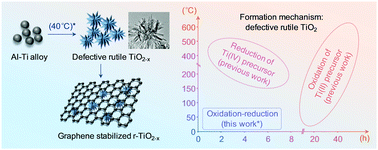Tailored dealloying-driven, graphene-boosted defective rutile TiO2−x for long-term lithium storage†
Abstract
Ti3+ self-doping and/or an oxygen defect-induced impurity level in TiO2 lattices can serve as charge transfer carriers to accelerate electronic conduction, enabling TiO2 to be a promising anode alternative in lithium-ion batteries. Although previously reported post-reduction of Ti(IV) intermediates and direct oxidation of Ti(II) precursors can be used to prepare defective rutile TiO2, these processes usually require elevated temperatures. Herein, a tailored low-temperature dealloying approach, involving a new in situ oxidation–reduction mechanism, is proposed to synthesize blue defective rutile TiO2−x directly. The generated air-sensitive Ti3+ species on the surface are then handily stabilized by coupling with graphene. As a result, the TiO2−x/graphene composites exhibit desirable lithium storage capacities and outstanding long-term cycling stability (157 mA h g−1 at 1C after 1400 cycles) owing to the [001]-axis oriented nanorod self-assembly, faster electron transfer, and improved Li+ diffusivity. This work highlights a new formation mechanism of defective rutile TiO2−x, and considering the convenience and simplicity, it will provide new inspiration to the conventional dealloying strategy for low-temperature synthetic chemistry.



 Please wait while we load your content...
Please wait while we load your content...